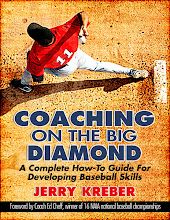Wednesday, March 15, 2006
The Next Stage

Stage Five:
Front-Side Tilt
Front-Side Tilt
Almost in unison with the Stage Four, effective pitchers will have front side shoulder tilt. The tilt, in the front side, is a direct result of a full upper arm circle by the pitcher. As the pitcher extends their arm out of the glove, their glove side will naturally rise. Their glove side will provide leverage toward the plate. Increased leverage will not only provide directional support, but higher pitch velocities
As the pitcher circles their upper pitching arm, the pitchers glove side elevates higher than the pitching arm. The pitcher’s glove arm should be extended, pointing directly at the target. The pitcher’s glove arm should stay in a straight line with the target. Keeping the line straight, allows the pitcher to apply all available force forward. Furthermore, keeping in a straight line with the target, forces the pitcher not to bring the ball behind their body. Once the ball is behind the pitcher’s body, they must pull their glove side to side to release the pitch for a strike. Using lateral directional force puts a tremendous amount of strain on the elbow.
Higher velocity is another benefit of the front side shoulder tilt. First, pitchers get to couple the force to the plate by using the glove arm. If the glove arm is extended and raised, pitchers are allowed to pull them forcefully toward second base. This action should increase the momentum and speed of the throwing arm. Secondly, when a pitcher’s forearm is not turned over, force is not being applied to the back of the ball. The humerus bone, when external rotated, turns the forearm over. The earlier the humerus bone is externally rotated the more time the pitcher can apply force to the ball.

As you can see, in each picture posted, every athlete is demonstrating a front side shoulder tilt. Not only is the tilt practiced in baseball, but football as well. Look at Tommy Maddox, he is showing how the tilt is used to create force while throwing a football. The tilt is created by flexion in the rear leg which happens during Stage III.
Monday, March 06, 2006
Stage IV

Stage Four:
Upper Arm Circle
The next two stages happen almost in unison. But, if you break the delivery down it can be deduced that one is the direct effect of the other. During the leg bend, pitchers must break their hands correctly to efficiently deliver their pitch to the target. Many experts have weighed in on when the pitcher should break their hands. Some say the earlier the better, while other contest pitchers should wait until later as they head toward. Upper Arm Circle
Not only when the pitcher breaks their hands is a point of contention, but how they do it is also questionable. Some say that a pitcher should lift their arm up, while others say the pitcher should swing their pitching arm back. While looking at video, pictures, and research I have concluded that the arm swing is the best approach for pitchers wanting to reach maximum velocity, stay healthy, and maintain durability.
The arm swing of the pitcher begins after the ball is taken out of the glove. The ball should be taken out of the glove low, giving the arm an adequate distance to gain momentum. After hand break, the pitcher must point their glove hand at the target. Thus, ensuring the glove shoulder points directly at the target at all times. The elbow should initially travel back towards 1st base. When the ball, held in the pitcher’s hand, achieves a straight-line starting with home plate, pitcher’s throwing hip, and second base the pitcher will forcefully turn their hips and shoulders toward the target.
Posted on this page are three different pictures of pitchers that practice a true upper arm circle. First, notice the picture of Tom Glavine after the hand break. His elbow’s first movement is back and then up. The ball never reverse rotates behind his body, instead it stops it a straight line with home plate, his body, and second base.
Observe the picture of Nolan Ryan. He is in a position similar to Glavine, staying in a straight line with the target. In the picture, Ryan takes the ball out low, out of the hand break. His elbow swings back and then up creating speed toward the target. Since Ryan takes the ball out low he has more distance to gain arm speed, thus releasing a pitch with more velocity and maintaining a healthy arm.
Finally, posted on this page is a picture of Roger Clemens. In the picture, Clemens has just finished the hand break. Again, notice how low he takes the ball out. If his arms were on a clock dial, Clemens would break his hands at a 6 o’clock position and move his arm through the 7, 8, 9, and 10 positions before the release.
